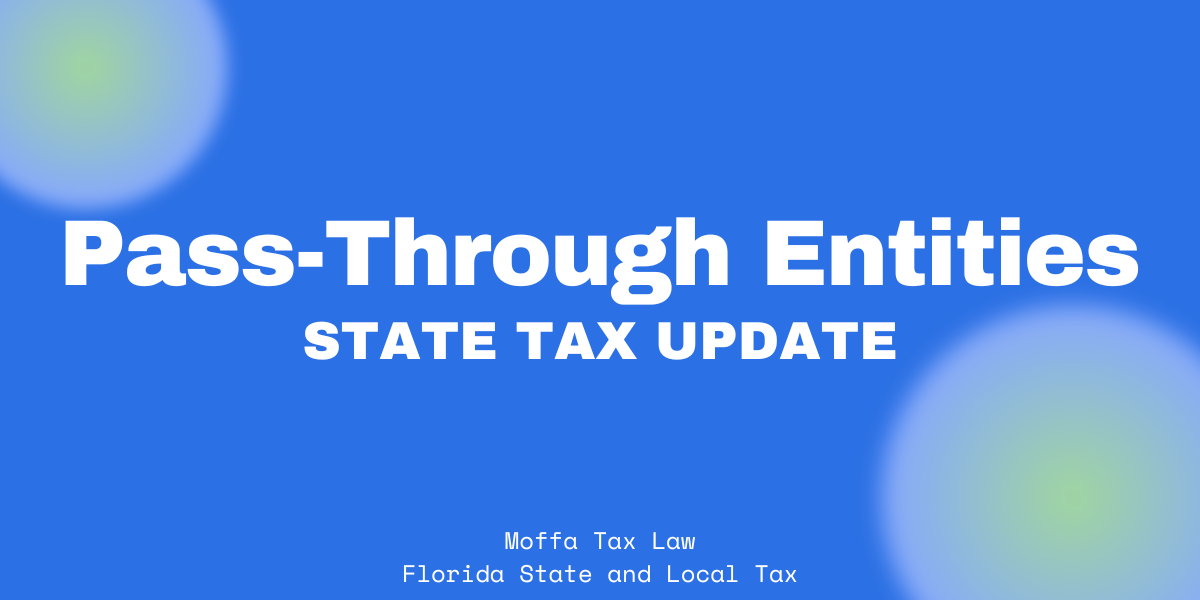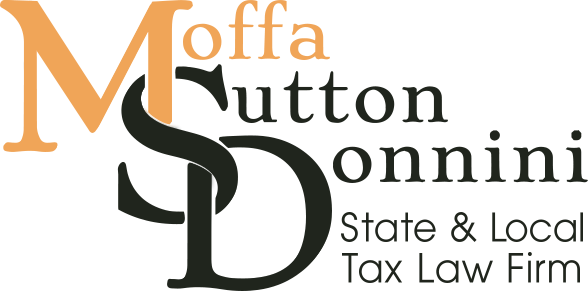NEWS & INSIGHTS


Pass-through entities (PTEs) have long been a critical component of the U.S. tax system, providing business owners with flexibility in structuring their tax liabilities. However, recent state-level legislative and administrative changes, as well as federal developments, continue to shape the taxation of these entities. The Pass-Through Entities Subcommittee of the ABA State and Local Tax Committee recently released a report highlighting major updates across various states and providing insight into future trends for PTE taxation.
One of the most significant drivers of these changes has been the federal cap on state and local tax (SALT) deductions, introduced by the Tax Cuts and Jobs Act (TCJA) of 2017. In response, many states have enacted PTE-level taxes as a workaround to allow business owners to deduct state taxes at the entity level rather than on their personal tax returns. With the SALT cap set to sunset in 2025, states are now reevaluating these tax structures. Additionally, recent rulings and administrative actions have impacted apportionment rules, sales of partnership interests, and investment partnership taxation, creating new compliance challenges for businesses.
This article explores the latest state legislative and administrative updates, recent court decisions, and the potential future of pass-through taxation at both the state and federal levels.
State-Level Developments in Pass-Through Entity Taxation
Expansion and Refinement of PTE Taxes
As more states adopt PTE taxes to address the SALT deduction cap, they continue to refine their systems to enhance clarity, fairness, and compliance. Several recent legislative and administrative changes highlight this trend:
Hawaii: In June 2024, Hawaii amended its PTE tax law to reduce the tax rate on the distributive share of income attributable to “qualified members.” Additionally, the law now allows qualified members to carry forward unused portions of their PTE tax credit indefinitely. Temporary administrative rules were adopted in December 2024 to clarify estimated payments and compliance requirements for tax years 2024 onward.
Iowa: The Iowa Department of Revenue modified the deadline for making a PTE tax election. For tax years beginning on or after January 1, 2023, the deadline is now six months after the original due date of a pass-through entity’s income tax return.
Michigan: A significant amendment to the state’s flow-through entity (FTE) tax was enacted in January 2025, with retroactive effect for tax years beginning on or after January 1, 2024. The election deadline is now the ninth month after the tax year ends, and members may claim credits for taxes paid through the extended due date. Michigan also expanded safe harbor provisions for estimated taxes, reducing the risk of penalties for underpayments.
As the SALT cap is set to expire at the end of 2025, many states are considering whether to extend or phase out their PTE tax regimes. States such as Illinois and Virginia have already proposed legislation to continue these taxes beyond 2025, and more states are expected to follow suit.
Apportionment and Sales of Partnership Interests
The treatment of pass-through entities for income apportionment purposes has also been evolving. Two major developments stand out:
Massachusetts: The state amended its regulations in January 2025 to confirm that the single sales factor apportionment method, previously applied to corporations, now also applies to pass-through entities. The statutory language in the 2023 legislation was ambiguous, prompting the Department of Revenue to issue regulatory guidance clarifying that pass-through entities must apportion income based solely on sales beginning in tax year 2025.
Virginia: A recent court decision in Department of Taxation v. FJ Management, Inc. addressed whether a corporate partner could be required to include a partnership’s apportionment factors in its own tax calculation. The Virginia Court of Appeals sided with the taxpayer, ruling that a corporate partner should not be required to use the apportionment factors of a partnership in which it owns a minority interest unless the two entities are engaged in a unitary business. The ruling clarified that the Due Process and Commerce Clauses prohibit mandatory combination of non-unitary business activities for tax apportionment purposes.
These cases highlight an ongoing national debate over how pass-through income should be sourced and taxed, particularly when partnerships operate across multiple states.
Investment Partnerships: Allocation of Income
The taxation of investment partnerships has been another area of legislative activity. Indiana recently introduced a bill to clarify how nonresident partners should allocate their income from investment partnerships. Key provisions of the bill include:
Income will generally be allocated to the partner’s state of domicile.
Exceptions apply if the investment income is integrally related to business activities conducted in Indiana, in which case it will be treated as business income subject to apportionment.
To qualify as an investment partnership, at least 90% of assets and gross income must come from qualifying investment securities.
This legislation reflects a broader trend among states to distinguish investment-related income from operational business income, reducing tax burdens on passive investors while maintaining tax obligations for active business participants.
IRS and Multistate Tax Commission Developments
Increased IRS Scrutiny of Pass-Through Entities
In October 2024, the IRS announced the creation of a new PTE compliance unit within its Large Business & International Division (LB&I). The goal of this unit is to increase audit rates for pass-through entities, with particular focus on large partnerships.
The IRS initiated audits of 76 of the largest partnerships, each with assets exceeding $10 billion.
A shift in IRS policy means that geographically based teams will now handle PTE audits instead of splitting them between LB&I and the Small Business/Self-Employed (SB/SE) divisions.
The number of IRS audits of PTEs was down in 2024 due to training of new agents but is expected to increase significantly in 2025.
These IRS efforts suggest that pass-through entity structures will face higher levels of federal scrutiny, potentially impacting compliance costs and tax planning strategies.
Multistate Tax Commission (MTC) Updates on Partnership Taxation
The MTC State Taxation of Partnerships Work Group has been focusing on sourcing rules for tiered partnership structures. At its December 2024 meeting, the Work Group discussed:
The development of a Microsoft Excel model to compare separate vs. blended apportionment for tiered partnerships.
The complexities of intercompany transactions and special allocations.
How corporate partners in multi-tiered structures should source income across multiple states.
The next phase of this project involves gathering input from state tax agencies and testing blended apportionment methodologies to determine whether they can be practically implemented.
Conclusion: The Future of Pass-Through Taxation
As pass-through entity taxation continues to evolve, businesses and tax practitioners must stay informed of state legislative updates, IRS compliance initiatives, and court rulings that could affect tax obligations. With the SALT cap set to expire at the end of 2025, states are actively reviewing whether to extend, modify, or phase out PTE tax regimes.
Key takeaways include:
More states are refining their pass-through entity tax structures, with Hawaii, Iowa, and Michigan implementing key changes in 2024 and 2025.
Apportionment rules for multi-state partnerships remain an area of contention, as demonstrated by recent developments in Massachusetts and Virginia.
The IRS and MTC are increasing scrutiny on tiered partnerships and large pass-through entities, potentially leading to higher audit rates and more regulatory oversight.
As these changes unfold, businesses must ensure compliance with evolving tax laws while optimizing their entity structures for maximum tax efficiency. The landscape of pass-through taxation is rapidly shifting, and staying ahead of these developments will be crucial for business success in the years ahead.
Share
Additional Articles by the SALTy Orange at Moffa Tax Law:
Florida Repeals Sales Tax on Commercial Rent — Will DeSantis Sign the Landmark 2025 Tax Cut?
NEWS & INSIGHTS Florida Repeals Sales Tax on Commercial Rent — Will DeSantis Sign the Landmark 2025 Tax Cut? …
NEWS & INSIGHTS Is Bottled Coffee Subject to Florida Sales Tax? The Answer May Surprise You Is Bottled Coffee Subject…
Inside the ABA SALT Committee Meeting: What Tax Professionals Need to Know About the Annual May Conference in D.C.
NEWS & INSIGHTS Inside the ABA SALT Committee Meeting: What Tax Professionals Need to Know About the Annual May Conference…

Jeanette Moffa, Esq.
(954) 800-4138
JeanetteMoffa@MoffaTaxLaw.com
Jeanette Moffa is a Partner in the Fort Lauderdale office of Moffa, Sutton, & Donnini. She focuses her practice in Florida state and local tax. Jeanette provides SALT planning and consulting as part of her practice, addressing issues such as nexus and taxability, including exemptions, inclusions, and exclusions of transactions from the tax base. In addition, she handles tax controversy, working with state and local agencies in resolution of assessment and refund cases. She also litigates state and local tax and administrative law issues.


